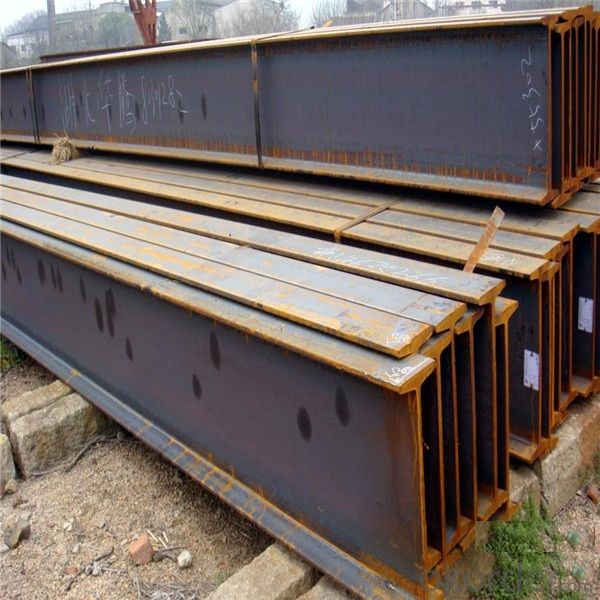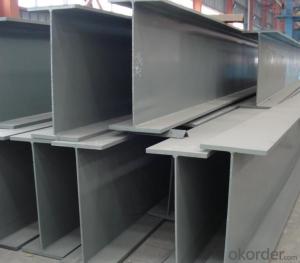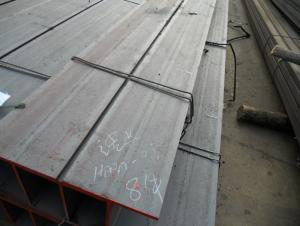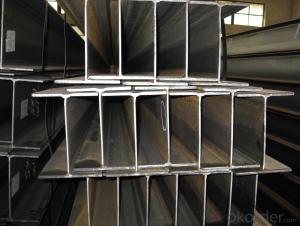Jis Structural H Steel Beams Price per Kg
- Loading Port:
- Dalian
- Payment Terms:
- TT OR LC
- Min Order Qty:
- 135 m.t
- Supply Capability:
- 150000 m.t/month
OKorder Service Pledge
OKorder Financial Service
You Might Also Like
Item specifice
Quick Detail
Place of Origin: | Jiangsu, China (Mainland) | Grade: | SS400, SS400,ST37-2, A36, S235JR, Q235 | Technique: | Hot Rolled |
Thickness: | 8mm | Application: | construction | Length: | 6m-16m |
Standard: | JIS, ASTM,BS,EN | Flange Width: | 50-34mm | Flange Thickness: | 7-34mm |
Web Width: | 100-900mm | Web Thickness: | 5-30mm | Brand Name: | JZZHD |
Model Number: | 350mm*175mm*7mm*11mm | Name: | Steel h beam structure material/ construction steel | Certificate: | SGS,ISO,CE,TUV |
We can provide qualify goods,competitive price and speedy delivery.

Products Description
H Type Steel Size and Theoretical Weight | |||||
Size | Theoretical Weight | Size | Theoretical Weight | Size | Theoretical Weight |
|
|
|
|
|
|
(mm) | (kg/m) | (mm) | (kg/m) | (mm) | (kg/m) |
100*50*5*7 | 9.3 | 250*125*6*9 | 29 | 446*199*8*12 | 65.1 |
100*100*6*8 | 16.9 | 250*250*9*14 | 71.8 | 450*200*9*14 | 74.9 |
125*60*6*8 | 13.1 | 294*200*8*12 | 55.8 | 482*300*11*15 | 110.8 |
125*125*6.5*9 | 23.6 | 298*149*5.5*8 | 32 | 488*300*11*18 | 124.9 |
148*100*6*9 | 31.1 | 340*250*9*14 | 36.7 | 496*199*9*14 | 77.9 |
150*75*5*7 | 14 | 300*150*6.5*9 | 93 | 500*200*10*16 | 88.1 |
150*150*7*10 | 20.7 | 300*300*10*15 | 78.1 | 582*300*12*17 | 132.8 |
175*90*5*8 | 18 | 346*174*6*9 | 41.2 | 588*300*12*20 | 147 |
175*175*7.5*11 | 40.4 | 350*175*7*11 | 49.4 | 596*199*10*15 | 92.4 |
194*150*6*9 | 29.9 | 350*350*12*19 | 134.9 | 600*200*11*17 | 103.4 |
198*99*4.5*7 | 17.8 | 390*300*10*16 | 104.6 | 700*300*13*24 | 181.8 |
200*100*5.5*8 | 20.9 | 396*199*7*11 | 56.1 | 800*300*14*26 | 206.8 |
200*200*8*12 | 49.9 | 400*200*8*13 | 65.4 | 900*300*16*28 | 240.1 |
244*175*7*11 | 43.6 | 400*400*13*21 | 171.7 |
|
|
248*124*5*8 | 25.1 | 440*300*11*18 | 120.8 |
|
|
Length=6------12meters | |||||
Packaging & Delivery
Packaging Details: | Packed with waterproof paper and steel banding. |
Delivery Detail: | 15-25 |
FAQ
1. How can I get some samples?
We are honored to offer you samples. New clients are expected to pay for the courier cost. The samples are free for you.
2 Do you have any certificates?
Our products passed inspection of SGS, FDA, and CE Quality is priority! Every worker keeps the QC from the very beginning to the very end, Quality control department especially responsible for quality checking in each process.
3 Can your factory print or emboss my logo on the goods?
Yes, we can print or emboss the logo on the goods or their packing box.
4 What information should I let you know if I want to get a quotation?
1) The specification of products (length x width x thickness);
2) The temper and alloy.
3) The final product you will use to be made
4 It will be better if you can show us the pictures or design sketch. Samples will be best for clarifying. If not, we will recommend relevant products with details for reference.We usually produce goods based on customers
Samples or based on customers’ picture, logo, sizes etc.
- Q:How do steel H-beams perform in high winds?
- Steel H-beams are renowned for their exceptional performance in high winds. Their structural design, featuring a broad flange and a vertical web, grants them superior strength and rigidity compared to materials like wood or concrete. Consequently, they exhibit high resistance to wind forces, ensuring stability during severe weather conditions. The H shape of the beams evenly distributes the load, minimizing wind-induced vibrations and reducing the risk of structural failure. Moreover, the vertical web provides added stiffness, enhancing their capacity to withstand lateral forces caused by high winds. Furthermore, steel H-beams can be custom-designed and manufactured to meet specific wind load requirements, making them suitable for various wind zones and regions with varying wind speeds. This flexibility allows for optimized performance in high winds, making them a reliable choice for structures in areas prone to strong gusts or hurricanes. In addition, steel is a highly durable and corrosion-resistant material, ensuring that steel H-beams remain resilient to the long-term effects of wind exposure. This characteristic guarantees their longevity and structural integrity, even under harsh wind conditions. To summarize, steel H-beams excel in high winds due to their superior strength, rigidity, and load distribution properties. Their ability to withstand wind-induced forces, combined with their durability, establishes them as a reliable choice for structures that must endure extreme weather conditions.
- Q:What are the different factors that affect the cost of steel H-beams?
- The cost of steel H-beams can be influenced by several factors. These factors include raw material costs, the manufacturing process, size and weight, quality and grade, market demand, transportation and logistics, market competition, and currency exchange rates. When it comes to raw material costs, the price of steel can be affected by factors like supply and demand, global economic conditions, and the cost of raw materials. Fluctuations in these factors can impact the overall cost of steel H-beams. The manufacturing process for steel H-beams involves various steps, such as melting, casting, rolling, and finishing. The complexity and efficiency of these processes can affect the cost of production, which, in turn, affects the final price of H-beams. The dimensions and weight of steel H-beams also play a significant role in determining their cost. Larger and heavier H-beams require more raw materials and additional manufacturing processes, resulting in higher costs. The quality and grade of steel used in H-beams can also influence their cost. Higher-grade steels with superior strength and durability tend to be more expensive compared to lower-grade options. The demand for steel H-beams can impact their cost as well. When demand is high and supply is limited, prices tend to rise. Conversely, when demand is low and supply exceeds it, prices may decrease. The cost of transporting steel H-beams from the manufacturing site to the buyer's location can add to the overall cost. Factors such as distance, mode of transportation, and fuel prices can affect transportation costs. The level of competition among steel manufacturers and suppliers can influence the pricing of H-beams. In a highly competitive market, companies may offer competitive pricing to attract customers, while in less competitive markets, prices may be higher. Steel is a globally traded commodity, and fluctuations in currency exchange rates can impact the cost of imported steel H-beams. Changes in exchange rates between the country of origin and the destination country can affect the final price. Considering these factors is crucial when estimating the cost of steel H-beams, as they can vary over time and have a significant impact on the overall budget for construction or manufacturing projects.
- Q:Are steel H-beams suitable for use in the construction of hospitality resorts or hotels?
- Yes, steel H-beams are suitable for use in the construction of hospitality resorts or hotels. They offer several advantages such as high strength, durability, and versatility in design. Steel H-beams provide excellent structural support, allowing for wide and open spaces, which are often desired in resorts and hotels. Additionally, steel beams are resistant to fire, pests, and weather conditions, ensuring the long-term stability and safety of the building.
- Q:What are the design considerations when using steel H-beams in buildings?
- When incorporating steel H-beams into building structures, it is imperative to take into account various significant design considerations. The following are a few essential factors to be mindful of: 1. Structural Strength: Steel H-beams are renowned for their exceptional strength-to-weight ratio, rendering them suitable for supporting substantial loads. The design must guarantee that the beams can endure the expected loads without excessive deflection or failure. 2. Span and Size: The structural integrity of the steel H-beams heavily relies on their span and size. The design must carefully consider the required span length and the load-bearing capacity of the beams to ensure that they can adequately support the intended load without buckling or excessive sagging. 3. Connections: The stability and strength of the steel H-beams greatly depend on proper connection design. The connections between the beams and other structural elements, such as columns and foundations, must be designed to efficiently transfer forces and resist any potential movement or deformation. 4. Fire Resistance: Steel H-beams are susceptible to heat, which can compromise their structural integrity. The design considerations should incorporate fire-resistant measures, such as the application of fireproof coatings or the utilization of fire-resistant insulation materials, to ensure the safety and stability of the building in the event of a fire. 5. Cost-effectiveness: Designers must also evaluate the cost-effectiveness of employing steel H-beams. This entails assessing the material costs, fabrication requirements, and construction methods associated with incorporating steel H-beams into the building design. By efficiently utilizing materials and optimizing beam sizes, costs can be reduced while maintaining structural integrity. 6. Building Codes and Regulations: Adhering to local building codes and regulations is of utmost importance when using steel H-beams in buildings. Designers must ensure that the structural design meets all pertinent codes and standards, including provisions for seismic resistance, wind loads, and other environmental factors. In conclusion, the design considerations associated with the usage of steel H-beams in building structures revolve around structural strength, size and span, connections, fire resistance, cost-effectiveness, and compliance with building codes. By diligently addressing these considerations, designers can ensure the secure and efficient utilization of steel H-beams in building structures.
- Q:Can steel H-beams be used for cantilever structures?
- Yes, steel H-beams can be used for cantilever structures. Cantilever structures are designed to have a projecting beam or member that is supported on only one end, with the other end free or unsupported. Steel H-beams are commonly used in construction due to their strength and load-bearing capabilities. They are well-suited for cantilever designs as they provide excellent structural support, minimizing deflection and ensuring stability. However, it is essential to consider the specific requirements of the cantilever structure and consult with a structural engineer to determine the appropriate size and strength of the H-beam needed to support the desired load and span.
- Q:Are steel H-beams resistant to ultraviolet (UV) radiation?
- Steel H-beams are not inherently resistant to ultraviolet (UV) radiation. UV radiation from the sun can cause degradation and discoloration of steel surfaces over time. However, the extent of this degradation depends on various factors such as the specific type of steel used and the duration and intensity of UV exposure. To mitigate the effects of UV radiation on steel H-beams, protective coatings can be applied. These coatings act as a barrier, shielding the steel from direct exposure to UV rays. Common protective coatings for steel include paint, powder coating, and galvanizing. Paint coatings provide a layer of protection against UV radiation, but they may require periodic maintenance and reapplication to ensure continued effectiveness. Powder coating, on the other hand, offers greater durability and resistance to UV radiation. Galvanizing is another option, where steel H-beams are coated with a layer of zinc to provide protection against UV radiation and corrosion. It is important to note that even with protective coatings, the long-term durability of steel H-beams under UV exposure will depend on factors such as the quality of the coating, the environment in which they are installed, and maintenance practices. Regular inspection and maintenance can help identify any signs of degradation or damage and allow for timely repairs or reapplication of protective coatings if necessary. In summary, while steel H-beams are not inherently resistant to UV radiation, the use of protective coatings can significantly enhance their resistance to UV degradation and extend their lifespan.
- Q:Can steel H-beams be used for solar panel supports?
- Yes, steel H-beams can be used for solar panel supports. Steel H-beams provide excellent structural stability and strength, making them a suitable choice for supporting the weight of solar panels. Additionally, steel beams are durable and resistant to environmental factors, making them a reliable option for long-term support of solar panels.
- Q:How do you calculate the deflection limits for steel H-beams?
- To calculate the deflection limits for steel H-beams, several factors need to be taken into consideration. The deflection limits are typically determined by the applicable building codes or industry standards. The following steps outline the general process of calculating the deflection limits: 1. Determine the relevant building code or industry standard: The deflection limits are usually specified by building codes or industry standards, such as the American Institute of Steel Construction (AISC) code. These codes provide guidelines for the maximum permissible deflection based on the intended use of the structure. 2. Identify the properties of the H-beam: Gather the necessary information about the H-beam, including its dimensions, material properties, and support conditions. This information is typically provided by the manufacturer or can be obtained from relevant design resources. 3. Calculate the moment of inertia: The moment of inertia is a measure of the beam's resistance to bending. It is calculated based on the beam's dimensions and geometry. The moment of inertia plays a crucial role in determining the deflection of the beam. 4. Determine the applied load: Identify the load or loads that will act on the H-beam. This could include dead loads, live loads, wind loads, or any other relevant loads as specified by the design requirements. 5. Apply the appropriate deflection formula: The specific deflection formula to be used will depend on the type of loading and support conditions. Common deflection formulas include the Euler-Bernoulli beam equation, which assumes linear elastic behavior, and the Timoshenko beam equation, which accounts for shear deformations. 6. Calculate the maximum allowable deflection: Using the deflection formula, input the relevant parameters such as the applied load, beam properties, and support conditions to calculate the deflection at various points along the beam. Compare the calculated deflection values to the deflection limits specified in the building code or industry standard. 7. Ensure compliance with deflection limits: If the calculated deflection exceeds the specified limits, adjustments need to be made to the beam's dimensions, material, or support conditions. This may involve increasing the beam size, using a higher-strength material, or adding additional support. It is important to note that the process of calculating deflection limits for steel H-beams can be complex and may require the expertise of a structural engineer or designer. Additionally, it is crucial to adhere to the applicable building codes and industry standards to ensure the safety and structural integrity of the project.
- Q:What are the energy efficiency benefits of using steel H-beams?
- Using steel H-beams in construction projects offers numerous energy efficiency benefits. Firstly, steel is an incredibly sustainable and eco-friendly material. It can be recycled indefinitely without any loss in quality, reducing the need for new production and mining of raw materials. This not only saves energy but also decreases the environmental impact of construction. Secondly, steel H-beams possess a high strength-to-weight ratio. This means they can support heavy loads while being relatively lightweight themselves. Consequently, less material is required for building construction, resulting in reduced energy consumption during manufacturing and transportation. Additionally, the lightweight nature of steel H-beams allows for more efficient construction processes, saving time and energy. Moreover, steel H-beams are highly durable and long-lasting. They are resistant to corrosion, fire, and pests, making them incredibly resilient. By using steel H-beams, buildings can withstand harsh weather conditions and natural disasters, reducing the need for frequent repairs or replacements. This durability leads to long-term energy savings as maintenance and replacement costs are minimized. Lastly, steel H-beams contribute to energy efficiency through their thermal properties. Steel is an excellent conductor of heat, enabling efficient temperature regulation in buildings. As a result, steel H-beams help minimize heat loss during colder seasons, reducing the need for excessive heating and lowering energy consumption and costs. In conclusion, using steel H-beams in construction projects offers energy efficiency benefits such as reduced energy consumption during manufacturing and transportation, minimized maintenance and replacement costs, and improved thermal insulation properties. By incorporating steel H-beams into construction projects, we can create more sustainable and energy-efficient buildings, contributing to a greener future.
- Q:What are the cost implications of using steel H-beams?
- The cost implications of using steel H-beams can vary depending on multiple factors. Initially, the upfront cost of steel H-beams may be higher compared to other building materials. However, steel H-beams provide numerous long-term cost benefits. They are incredibly durable and resistant to wear and tear, reducing the need for frequent repairs or replacements. Additionally, steel H-beams are highly versatile and can support large loads, allowing for efficient structural designs and potentially reducing the overall construction costs. Furthermore, steel is a sustainable and recyclable material, which can contribute to cost savings in terms of waste management. Overall, while the initial investment may be higher, the long-term cost savings and advantages offered by steel H-beams make them a favorable choice for many construction projects.
1. Manufacturer Overview |
|
|---|---|
| Location | |
| Year Established | |
| Annual Output Value | |
| Main Markets | |
| Company Certifications | |
2. Manufacturer Certificates |
|
|---|---|
| a) Certification Name | |
| Range | |
| Reference | |
| Validity Period | |
3. Manufacturer Capability |
|
|---|---|
| a)Trade Capacity | |
| Nearest Port | |
| Export Percentage | |
| No.of Employees in Trade Department | |
| Language Spoken: | |
| b)Factory Information | |
| Factory Size: | |
| No. of Production Lines | |
| Contract Manufacturing | |
| Product Price Range | |
Send your message to us
Jis Structural H Steel Beams Price per Kg
- Loading Port:
- Dalian
- Payment Terms:
- TT OR LC
- Min Order Qty:
- 135 m.t
- Supply Capability:
- 150000 m.t/month
OKorder Service Pledge
OKorder Financial Service
Similar products
New products
Hot products
Hot Searches
Related keywords



























